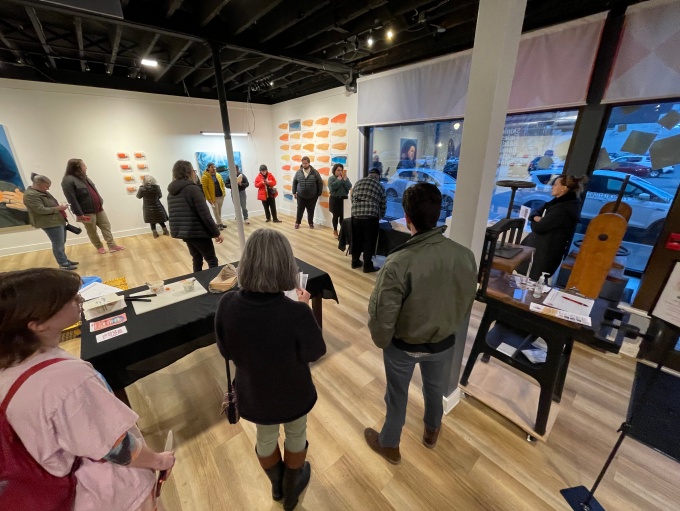Published June 20, 2024
Review of "Skinless Finless Headless Boneless Gutless Spineless"
Lydia Kegler (UB MFA, 2024), writes about "Skinless Finless Headless Boneless Gutless Spinelessk", the MFA thesis exhibition of Dalton Carlson.
A school of disembodied salmon filets spans across the right wall of the Western New York Book Arts Center Gallery. Each filet is printed on an individual rectangle of paper, arranged in eight rows of five, in hues of peach, vermillion, yellow, and the occasional blue. Salmon are beautifully strewn over every surface of the gallery, including the floor, in varying states of dismemberment. The artist, Dalton Carlson, is the other character who reappears in painted, and printed forms, with salmon in, on and around him. In the painting “Salmo Domesticus”, Carlson, wearing his grocery store “Seafood Team Member” uniform, literally swims with the fishes. He is floating in water, positioned with arms by his sides, laying horizontal alongside the school of salmon surrounding him. Skinless Finless Headless Boneless Gutless Spineless is a solo exhibition created by Carlon for his MFA from University at Buffalo in Studio Art.
The oil paintings, monotype and woodblock prints, and sculptures in Skinless Finless Headless Boneless Gutless Spineless are tied together by repeating imagery of salmon, and the occasional cameo self-portrait. Mounted on the left wall are what appear to be many individually packaged salmon filets, but looking closer it becomes clear that each unique shade of orange filet is made from folded paper that has been monotype printed. Half inch sized portraits of the artist are repeatedly stamped onto the filet, forming its white lines of fat. “Transformation” is the largest oil painting in the exhibit and serves as a central point of focus in the space. A bust portrait of the artist covers almost the entire four by six foot canvas. The artist looks out as though looking into a mirror, pulling the collar of his t-shirt down to reveal the blushing vermillion of salmon flesh on his own skin. He wears an expression of concern.
Themes of domestication, consumption, mass production, and labor are prevalent in Skinless Finless Headless Boneless Gutless Spineless. The artist’s personal experience as a “Seafood Team Member” at a multinational grocery store is indicated by the presence of his uniform physically hanging on the wall, as well as painted into the works. However, there is also an intangible presence of the artist’s personal relationship to the fish throughout the show. Perhaps it is conveyed through the many forms, textures, and stages of life that the salmon appears in, or perhaps it is in the overlapping between artist and fish, on and in each other. Skinless Finless Headless Boneless Gutless Spineless is on view at the Western New York Book Arts Center from March 19th to April 12th, 2024.
Photos by Jeffrey Sherven, from the reception of "Skinless Finless Headless Boneless Gutless Spineless " at WNY Book Arts Center


About The Western New York Books Arts Center
Location
468 Washington Street, Buffalo, NY 14203
Mission
The Western New York Book Arts Center promotes greater understanding of printing and book-related arts through education, creation, and exhibition for a broad and diverse community.
History (abbreviated, from: https://wnybookarts.org/about/)
Founded in 2006 by Richard Kegler and Carima El-Behairy, the Western New York Book Arts Center was originally known as the Western New York Book Arts Collaborative before we found our home at 468 Washington Street. After formally becoming incorporated as a 501(c)3 nonprofit organization in 2008 and purchasing our building shortly thereafter, we started to be known as a center even though collaboration is still at the heart of our mission—and on our paperwork, too!
Without a permanent home, the collective became known for street corner drama, poetry, and literary readings. Meanwhile, visual artists in the group started a program called Gallery Without Walls, staging temporary art exhibitions in various locations on the West Side of Buffalo. In 1981, this program formalized to become El Museo Francisco Oller y Diego Rivera, honoring two of the most esteemed Puerto Rican and Mexican artists, respectively. Since then, we have expanded our mission to include all underserved groups including people of African, Latino/a, Asian, Arab, and Native American descent, women artists, and our region’s growing population of immigrants and refugees. In 1997 we moved into our current space on Allen Street and have since presented numerous exhibitions and public programs promoting diversity and inclusion, dialogue, and excellence in the arts and humanities.